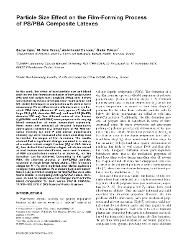| dc.contributor.author | Uğur, Şaziye | |
| dc.contributor.author | Sunay, M. Selin | |
| dc.contributor.author | Elaissari, Abdelhamid | |
| dc.contributor.author | Pekcan, Önder | |
| dc.date.accessioned | 2019-06-27T08:05:09Z | |
| dc.date.available | 2019-06-27T08:05:09Z | |
| dc.date.issued | 2010 | |
| dc.identifier.issn | 0272-8397 | en_US |
| dc.identifier.uri | https://hdl.handle.net/20.500.12469/1038 | |
| dc.identifier.uri | https://doi.org/10.1002/pc.20954 | |
| dc.description.abstract | In this work the effect of hard particle size and blend ratio on the film formation behavior of hard polystyrene (PS) and soft poly(n-butyl acrylate) (PBA) latex blends was studied by means of steady-state fluorescence and UV-visible techniques in conjunction with atomic force microscopy. Three different sets of latexes were synthesized: PBA latex (diameter 97 nm) pyrene (P)-labeled large PS (LgPS | en_US] |
| dc.description.abstract | diameter 900 nm) and small PS (SmPS | en_US] |
| dc.description.abstract | diameter 320 nm). Two different series of latex blends (LgPS/PBA and SmPS/PBA) were prepared with varying blend composition at room temperature separately. Films were then annealed at elevated temperatures above glass transition (T(g)) temperature of PS. Fluorescence intensity (I(P)) from P and photon transmission intensity (I(tr)) were measured after each annealing step to monitor the stages of film formation. The results showed that a significant change occurred in I(P) and I(tr) at a certain critical weight fraction (R(c)) of PBA. Below R(c) two distinct film formation stages which are named as void closure and interdiffusion were seen. However at PBA concentrations nearer to or above R(c) no film formation can be achieved. Comparing to the LgPS/PBA the sintering process of SmPS/PBA particles occurred at much lower temperatures. Film formation stages for R < R(c) were modeled and related activation energies were calculated. Void closure (Delta H) and interdiffusion (Delta E) activation energies for SmPS/PBA were also found smaller in comparing with LgPS/PBA series. However Delta H and Delta E values were not changed much with the blend composition for both series. POLYM. COMPOS. 31:1637-16522010. (C) 2009 Society of Plastics Engineers | en_US] |
| dc.language.iso | eng | en_US |
| dc.publisher | John Wiley & Sons Inc | en_US |
| dc.rights | info:eu-repo/semantics/openAccess | en_US |
| dc.subject | N/A | en_US |
| dc.title | Particle Size Effect on the Film-Forming Process of PS/PBA Composite Latexes | en_US |
| dc.type | article | en_US |
| dc.identifier.startpage | 1637 | en_US |
| dc.identifier.endpage | 1652 | |
| dc.relation.journal | Polymer Composites | en_US |
| dc.identifier.issue | 9 | |
| dc.identifier.volume | 31 | en_US |
| dc.department | Fakülteler, Mühendislik ve Doğa Bilimleri Fakültesi, Biyoinformatik ve Genetik Bölümü | en_US |
| dc.identifier.wos | WOS:000281123900016 | en_US |
| dc.identifier.doi | 10.1002/pc.20954 | en_US |
| dc.identifier.scopus | 2-s2.0-77956918127 | en_US |
| dc.institutionauthor | Pekcan, Önder | en_US |
| dc.relation.publicationcategory | Makale - Uluslararası Hakemli Dergi - Kurum Öğretim Elemanı | en_US |
















